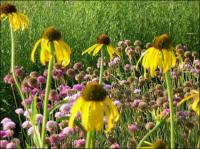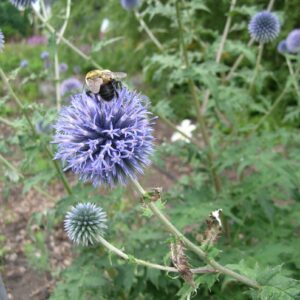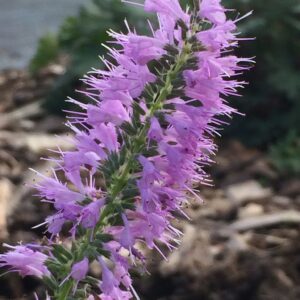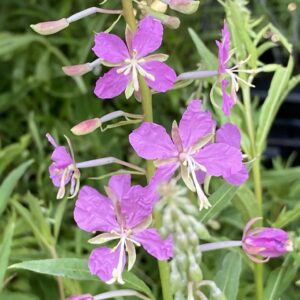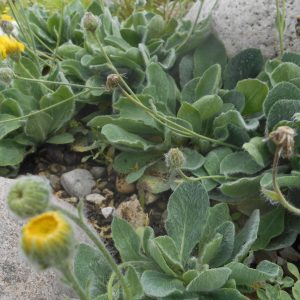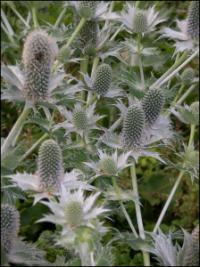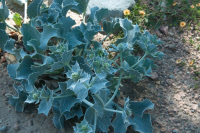Plants for Butterflies and Other Pollinators
Showing 73–80 of 211 results
-
Echinacea paradoxa Bush’s coneflower Z 3-9
Sulfur yellow petals droop down below the bristly, brown central cone- Blooms in early summer
Sulfur yellow petals droop down below the bristly, brown central cone- Blooms in early summer
Size: 2-4' x 14"
Care: sun to part shade in moist well-drained soil
Native: Ozark Mountains of Arkansas and Missouri
Wildlife Value: attracts bees and butterflies. In fall finches eat the seeds. Deer resistantEchinacea is Greek meaning hedgehog referring to the bristly conehead. Paradoxa because yellow petals on a Purple coneflower is a paradox. The first description of this is based on plants collected by B.F. Bush in Swan, Nichols Junction and Eagle Rock Missouri in 1878 and 1898 as well as one collected by German planthunter “Father of Texas Botany” Ferdinand Lindheimer in Texas in 1843. Transactions of the Academy of Science of St. Louis, Vol XII January to December, “Notes on Some Plants of the Southwestern United States” J.B.S. Norton 1902, p. 40.
-
Echinops ritro Globe thistle Z 3-9
Mid to late summer, round, steel blue flower heads at 1st prickly then turning soft and fuzzy.
Mid to late summer, round, steel blue flower heads at 1st prickly then turning soft and fuzzy.
Size: 3-4' x 18"
Care: Sun in well-drained soil, drought tolerant
Native: Southern Europe
Wildlife Value: attracts American painted lady butterflies, deer resistantThe name Echinops is Greek meaning “like a hedgehog” describing the circular spiny thistles. Introduced to England by 1570. Popular Victorian flower. Cultivated by Washington at Mount Vernon.
-
Elsholtzia stauntonii mu xiang ru in China, Chinese mint Z 4-8
Tube-shaped purple flowers ascend in spires in fall on this subshrub that dies back in colder areas to regrow from the roots in spring. Valuable for its late bloom and fragrant foliage.
Tube-shaped purple flowers ascend in spires in fall on this subshrub that dies back in colder areas to regrow from the roots in spring. Valuable for its late bloom and fragrant foliage.
Size: 3-5’ x 3-5'
Care: sun in moist well-drained to well-drained soil
Native: hills, mountainsides and river banks in Gansu, Hebei, Henan, Shaanxi, Shanxi, China
Wildlife Value: nectar for bees late in seasonChinese mint shrub was collected in 1790’s during England’s Macartney expedition to China. Named for Prussian horticulturist, author, and Doctor Johann Sigismund Elsholtz (1623-1688) and Sir George Staunton, baronet (1737 – 1801), secretary of the expedition. He authored the three-volume report of the expedition and collected plants including this. An Authentic Account of an Embassy from the King of Great Britain to the Emperor of China.
-
Epilobium angustifolium syn. Chamaenerion angustifolium Fireweed Z 2-7
Bright pink to lilac purple flowers June-July atop red stems covered in willow-like leaves
Bright pink to lilac purple flowers June-July atop red stems covered in willow-like leaves.
Can be slow to establish – be patient!
Size: 2-6’ x 3’ spreading
Care: Sun to part shade in dry to moist well drained soil
Native: Circum-polar to the temperate northern hemisphere. Wisconsin native.
Wildlife Value: Attracts hummingbirds, bees, and butterflies. Host for caterpillars of Fireweed Clearwing moth and Nessus Sphinx mothCommon name comes from its quick reappearance after a wildfire. Native Americans used fireweed externally for burns and other skin conditions, and made a tea for gastro-intestinal and bronchial problems. Its shoots eaten as a vegetable and young leaves added to salads. Fireweed yields a honey so prized that some Canadian beekeepers drive – or even fly – their hives to areas rich in fireweed for the blossoming season. Described and named by 1753.
-
Erigeron aureus Alpine yellow fleabane Z 5-8
White hairs cover frosted-looking basil leaves making this worthy of any garden even without flowers, but then its school bus yellow daisies flower from spring through fall.
OUT OF STOCK
White hairs cover frosted-looking basil leaves making this worthy of any garden even without flowers, but then its school bus yellow daisies flower from spring through fall.
Size: 3-4” x 3”
Care: sun in moist well-drained to well-drained soil
Native: Cascade Mountains from Alberta to State of Washington
Wildlife Value: attracts bees, butterflies and birds1st described in literature in 1884.
-
Eryngium giganteum Miss Wilmott’s ghost SELF-SEEDING BIENNIAL Z 5-8
In summer, oval thistles top prickly green, turning steely blue, silvery, bracts – very ornamental.
In summer, oval thistles top prickly green, turning steely blue, silvery, bracts – very ornamental.
Size: 36" x 24"
Care: Full sun in moist well-drained, fertile soil. Be sure to let it drop its seeds & do not weed seedlings out the following spring.
Native: Caucasus Mountains
Awards: England's Royal Horticultural Society Award of Merit.Eryngium is Greek for thistle. This species introduced to England in 1820. Miss Ellen Willmott (1858-1934), a wealthy, expert, eccentric English gardener reputedly dropped seeds as she passed her neighbors’ gardens. The plants came up afterwards, her “ghosts.” Recommended by Gertrude Jekyll in 1908.
-
Eryngium maritimum Sea holly Z 5-10
Round thistles turning steely blue in July-August atop silver colored, prickly bracts. Attractive ivy-shaped prickly foliage.
OUT OF STOCK
Round thistles turning steely blue in July-August atop silver colored, prickly bracts. Attractive ivy-shaped prickly foliage.
Size: 12" x 10" slowly spreads
Care: Full sun in well-drained soil.
Native: Seacoasts of Europe“Eryngium” is Greek for thistle. Anglo-Saxons prescribed Sea holly root to cure the king’s evil, serpent bites, broken bones, stiff necks and melancholy. Also considered an aphrodisiac and brought on “kissing comfits.” This was identified by Dioscorides in De Materica Medica for medicinal use around 70 A.D. Eryngium was described in Gerard’s Herball in 1597 for its uses:” old and aged people that are consumed and withered with age, and which want natural moisture (and also) amended the defects of nature in the younger,” William Robinson, father of the mixed perennial border, considered this plant “very pretty.”
-
Eryngium planum Flat sea holly Z 5-9
Round thistles top prickly steel blue, silver colored, bracts June-August. Stems turn steel blue too. Deadhead for repeat bloom. Reseeds readily. Great cut flowers: dry or fresh…
Round thistles top prickly steel blue, silver colored, bracts June-August. Stems turn steel blue too. Deadhead for repeat bloom. Reseeds readily. Great cut flowers: dry or fresh.
Size: 36” x 18”
Care: Sun well-drained soil, drought tolerant
Native: E. EuropeEryngium is Greek meaning “thistle.” Described in Gerard’s Herball in 1597 for its uses to remedy: “old and aged people that are consumed and withered with age, and which want natural moisture (and also) amended the defects of nature in the younger.”

